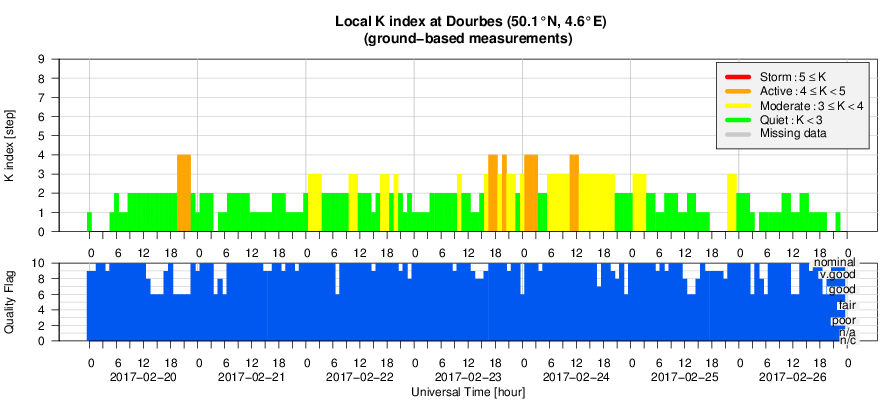- Table of Content
- 1.PROBA2 observe...
- 2.First GOES-16 ...
- 3.EUI getting re...
- 4.Review of sola...
- 5.PROBA2 Observa...
- 6.The Internatio...
- 7.Review of geom...
- 8.Geomagnetic Ob...
- 9.Review of iono...
- 10.Future Events
2. First GOES-16 solar images
3. EUI getting ready!...
4. Review of solar activity
5. PROBA2 Observations (20 Feb 2017 - 26 Feb 2017)
6. The International Sunspot Number
7. Review of geomagnetic activity
8. Geomagnetic Observations at Dourbes (20 Feb 2017 - 26 Feb 2017)
9. Review of ionospheric activity (20 Feb 2017 - 26 Feb 2017)
10. Future Events
PROBA2 observed a solar eclipse
A solar eclipse occurs when the Moon passes between the Sun and Earth, and the Moon covers (part of) the solar disk. When the Moon passes precisely the Sun-Earth line, it covers the entire solar disk and a total eclipse occurs. However, the Moon-Earth distance can vary considerably. Hence, sometimes the Moon is relatively far from the Earth. When that happens, its apparent size is not large enough to fully cover the Sun. Instead, we can see a ring of the Sun around the dark side of the Moon. This is called an annular eclipse.
On 26 February, lucky observers along the eclipse path in Chile, Argentina, Angola, Zambia and The Democratic Republic of the Congo have been able to witness such an annular eclipse. ESA's PROBA2 satellite, orbiting the Earth at an approximate height of 700 km, has also viewed this eclipse but as a partial one, due to its different vantage point. In fact, because the satellite only takes about 90 minutes to orbit the Earth, it passed through the Moon’s shadow several times during the event and so PROBA2 has not observed just one, but as many as 3 partial eclipses!
The full story is at the PROBA2 Science Centre website: http://proba2.oma.be/eclipse-february-2017
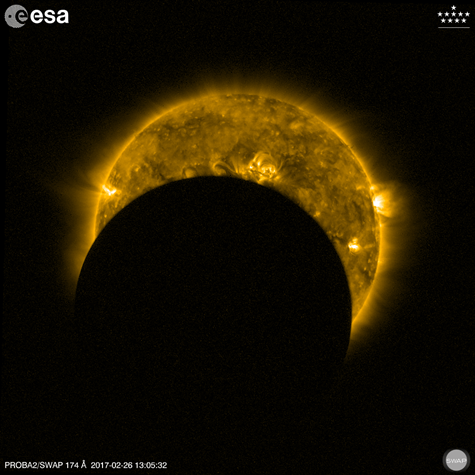
First GOES-16 solar images
There's a new entry in the space weather acronym list: SUVI. Indeed, the first images of the Solar Ultraviolet Imager onboard the GOES-16 satellite have been released and they are astonishing!
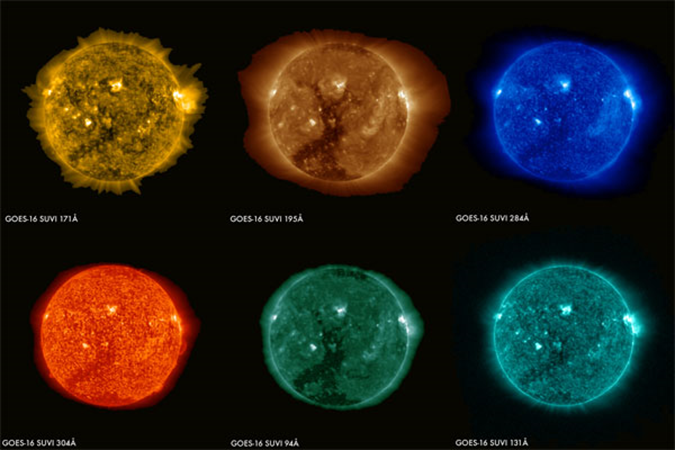
GOES-R was launched on 19 November 2016 and renamed to GOES-16 when it reached its geostationary orbit. After the necessary tests and check-outs, the release of the first magnetometer data, the first observed solar flare, and energetic particle measurements took place during the last few weeks. So, the time had come to put the cherry on the cake. Hence, on 27 February, NOAA released the first solar images obtained by SUVI. This instrument observes the Sun in 6 different wavelengths in extreme ultraviolet (EUV), providing an excellent view on everything that is going on in the solar atmosphere: quiet and active regions, coronal holes, solar flares, and the tell-tale signs of any coronal mass ejections (CMEs). All these are very important to the space weather community.
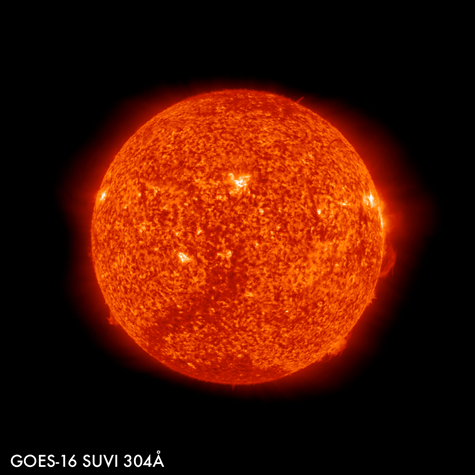
SUVI made its first images on 29 January, when an extension of a southern polar coronal hole was marking the solar corona. It can be seen in some SUVI passbands as a darkish extension upward the solar disk. One month later, this coronal hole has rotated back on the solar disk and may influence the earth environment again. Note that all these data and imagery are still preliminary and non-operational, as GOES-16 continues its on-orbit testing.
More info on GOES-16 and its space weather instruments can be found at the dedicated NASA and NOAA websites (https://www.nasa.gov/feature/goddard/2017/first-solar-images-from-noaas-goes-16-satellite , http://www.goes-r.gov/mission/firstSUVI_images.html ). More info on the SUVI instrument is at the GOES-16 website (http://www.goes-r.gov/spacesegment/suvi.html )
Congrats to the GOES-16 and the instruments teams!
EUI getting ready!...
Meanwhile, the folks at CSL (Centre Spatial de Liège, Belgium) are assembling and testing the EUI (Extreme Ultraviolet Imager). This is an instrument that will be onboard the ESA space mission Solar Orbiter, which is scheduled for launch in February 2019 (hot-of-the-press news). The mission will provide close-up, high-latitude observations of the Sun. Indeed, Solar Orbiter will have a highly elliptical orbit - between 0.9 (aphelion) and 0.28 (perihelion) times the sun-earth distance, that's at its closest within the orbit of the planet Mercury! Also, the spacecraft will gradually increase its inclination to the solar equator over time, reaching up to 25 degrees at the end of the nominal mission (approximately 7 years after launch) and up to 34 degrees in the extended mission phase. This will provide a much better view on the solar poles than we can have from Earth.
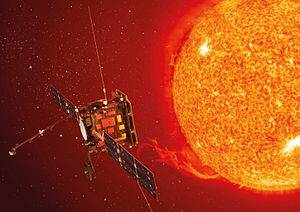
The EUI instrument will provide image sequences of the solar atmospheric layers above the photosphere, thereby providing an indispensable link between the solar surface and outer corona that ultimately shapes the characteristics of the interplanetary medium. EUI will also provide the first-ever UV images of the Sun from an out-of-ecliptic viewpoint (up to 34 degrees of solar latitude during the extended mission phase). Note that the very successful Ulysses, a past ESA/NASA mission (http://sci.esa.int/ulysses/ ), flew over the Sun's solar poles but kept well away from the Sun (more than the sun-earth distance) and without taking any images.
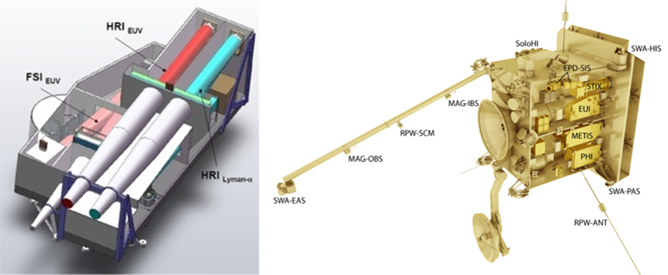
The EUI consortium consists of institutes from 5 different countries. The project is led by CSL, with an important contribution from the Royal Observatory of Belgium. The EUI is currently assembled and tested at CSL, with the men in white meticulously installing and connecting all the critical elements. More info on SolO and its instruments at the ESA website http://sci.esa.int/solar-orbiter/
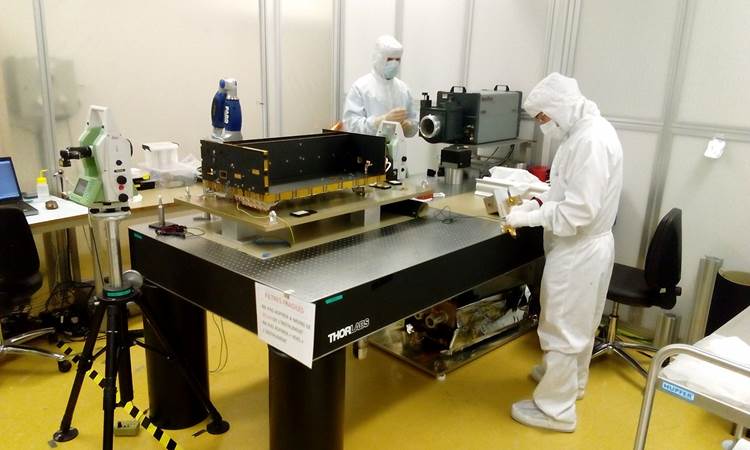
Review of solar activity
Solar activity was low throughout the week with only 3 C flares (the strongest a C4.1 peaking at 13:27UT February 22), all from NOAA region 2638 which was the only significant region throughout the week. The region was initially categorized as two separate sunspot groups by Catania (numbered 95 and 96). It contained and formed mixed polarity field in the middle section and around the leading spot of the most Southern group, but by the end of the week the smaller scattered sunspots disappeared and only a single alpha region remained.
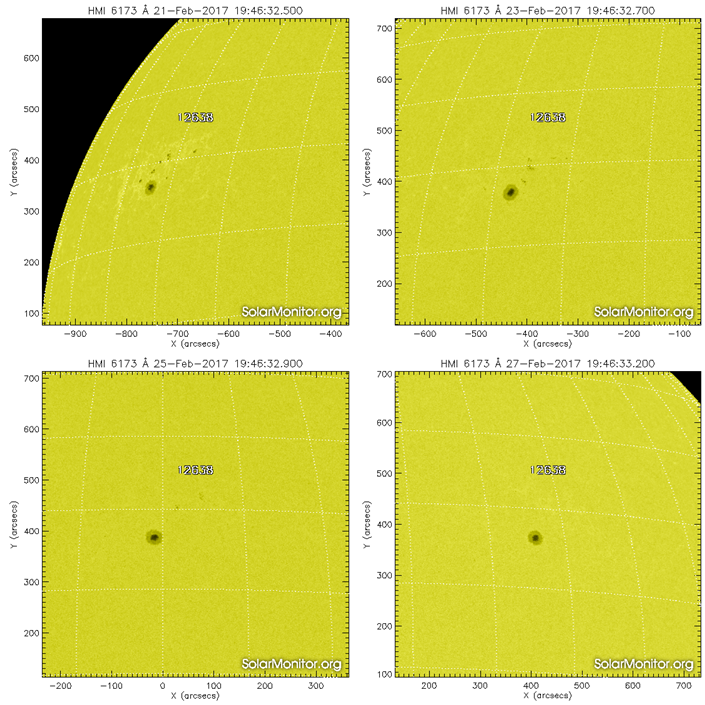
Two other regions (NOAA 2636 and 2637) were in decay at the start of the week while two new regions formed by the end of the week (NOAA 2639 and 2640). All these regions had fairly simple photospheric magnetic field configurations. No earth-directed coronal mass ejections (CMEs) were observed in coronagraph data throughout the week. Proton fluxes were at background levels throughout the week. The trans-equatorial extension of the southern polar coronal hole transited the central meridian midnight February 25/26 and is expected to influence solar wind conditions from February 28 onwards.
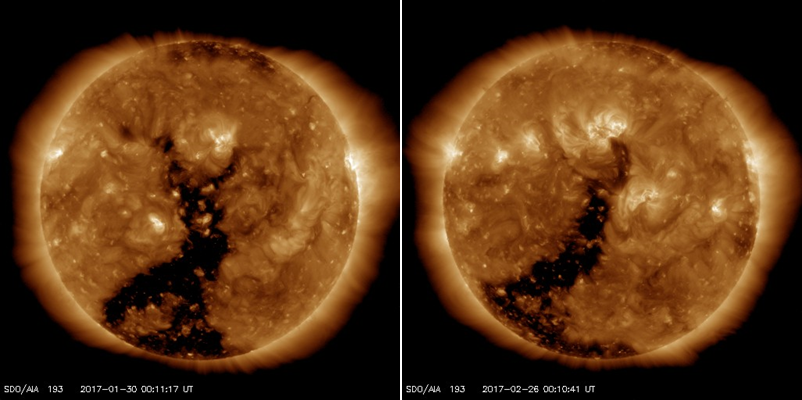
Download the running presentation of the Monday space weather briefing - http://www.stce.be/movies/SIDCbriefing-20170227.ppsm
PROBA2 Observations (20 Feb 2017 - 26 Feb 2017)
Solar Activity
Solar flare activity fluctuated between very low and low during the week.
In order to view the activity of this week in more detail, we suggest to go to the following website from which all the daily (normal and difference) movies can be accessed: http://proba2.oma.be/ssa
This page also lists the recorded flaring events.
A weekly overview movie can be found here (SWAP week 361): http://proba2.oma.be/swap/data/mpg/movies/weekly_movies/weekly_movie_2017_02_20.mp4
Details about some of this week’s events, can be found further below.
If any of the linked movies are unavailable they can be found in the P2SC movie repository here:
http://proba2.oma.be/swap/data/mpg/movies/
Monday Feb 20
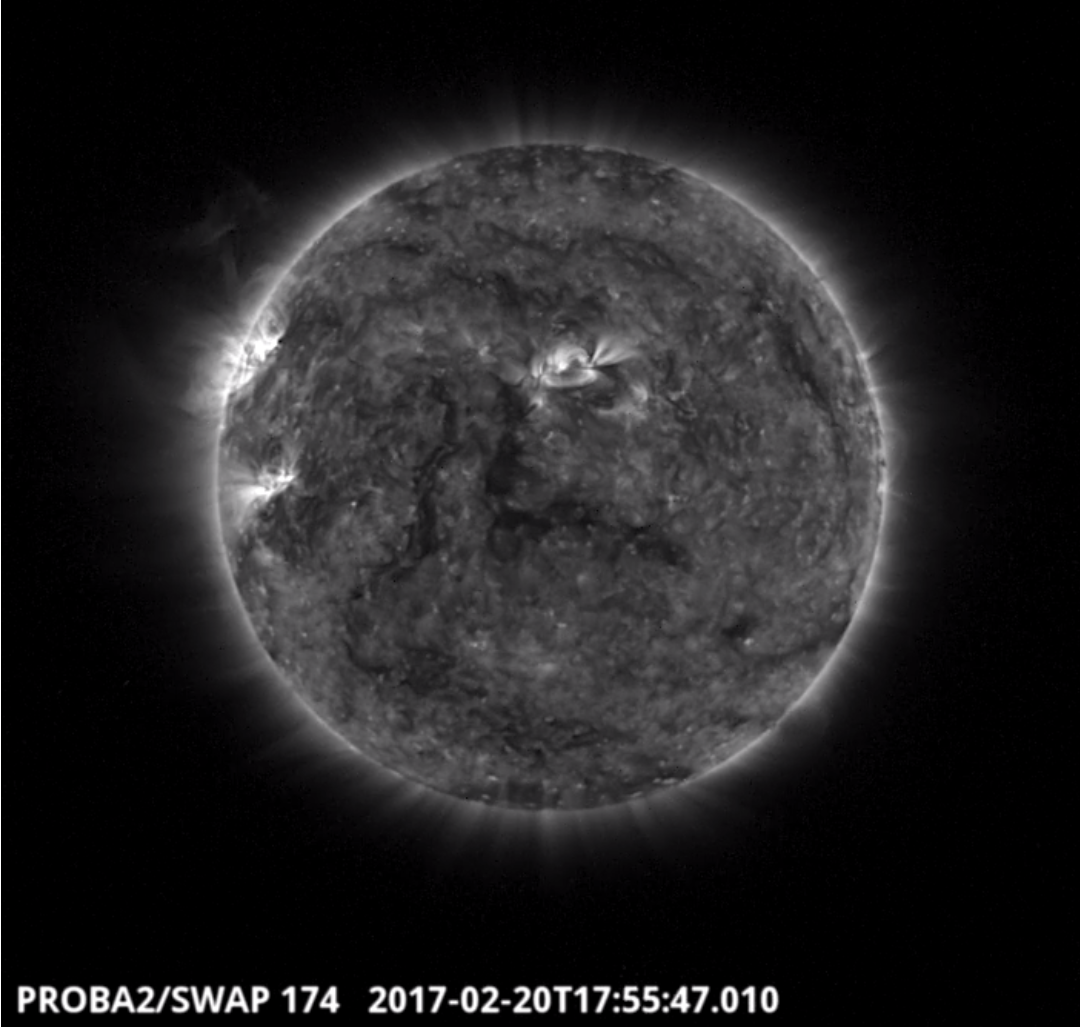
An eruption was observed by SWAP on the east limb of the Sun on 2017-Feb-20 at 17:55 UT.
Find a movie of the event here (SWAP movie):
http://proba2.oma.be/swap/data/mpg/movies/20170220_swap_movie.mp4
Wednesday Feb 22
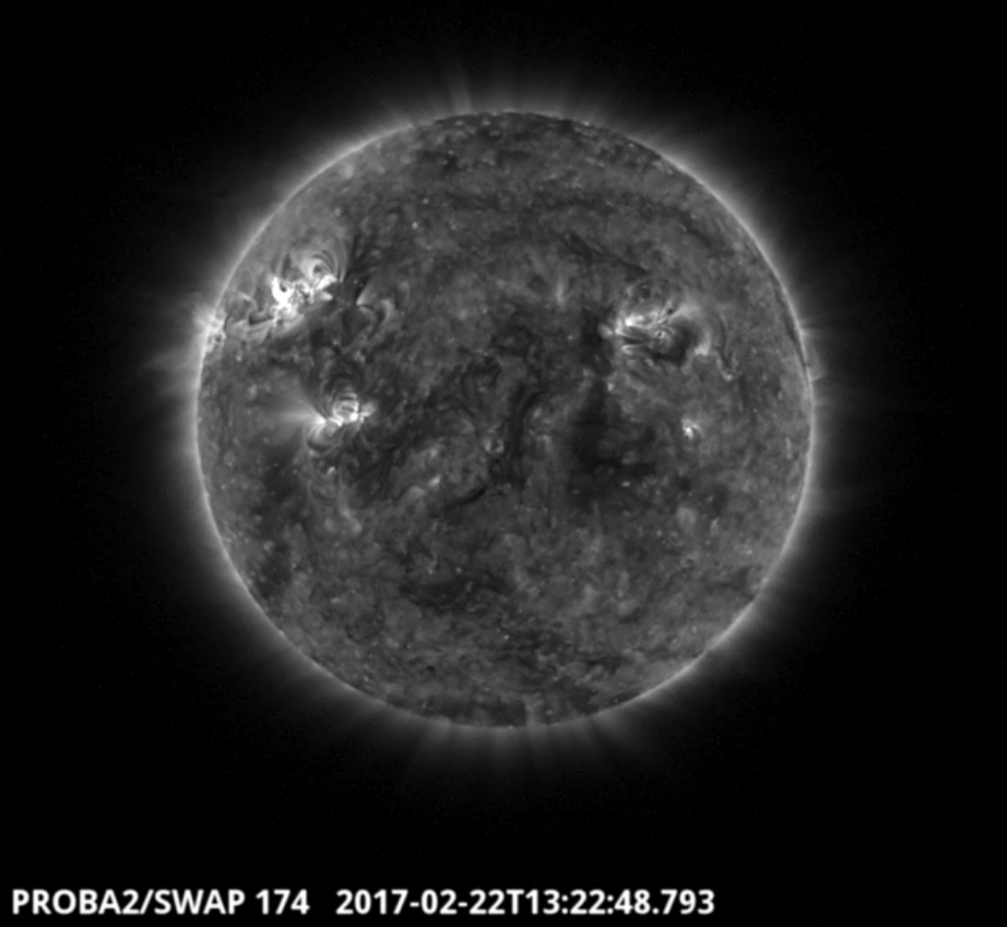
A C4.1 class flare was observed by SWAP in the Eastern hemisphere of the Sun on 2017-Feb-22 shown here at 13:22 UT
Find a movie of the events here (SWAP movie):
http://proba2.oma.be/swap/data/mpg/movies/20170122_swap_movie.mp4
Sunday Feb 26
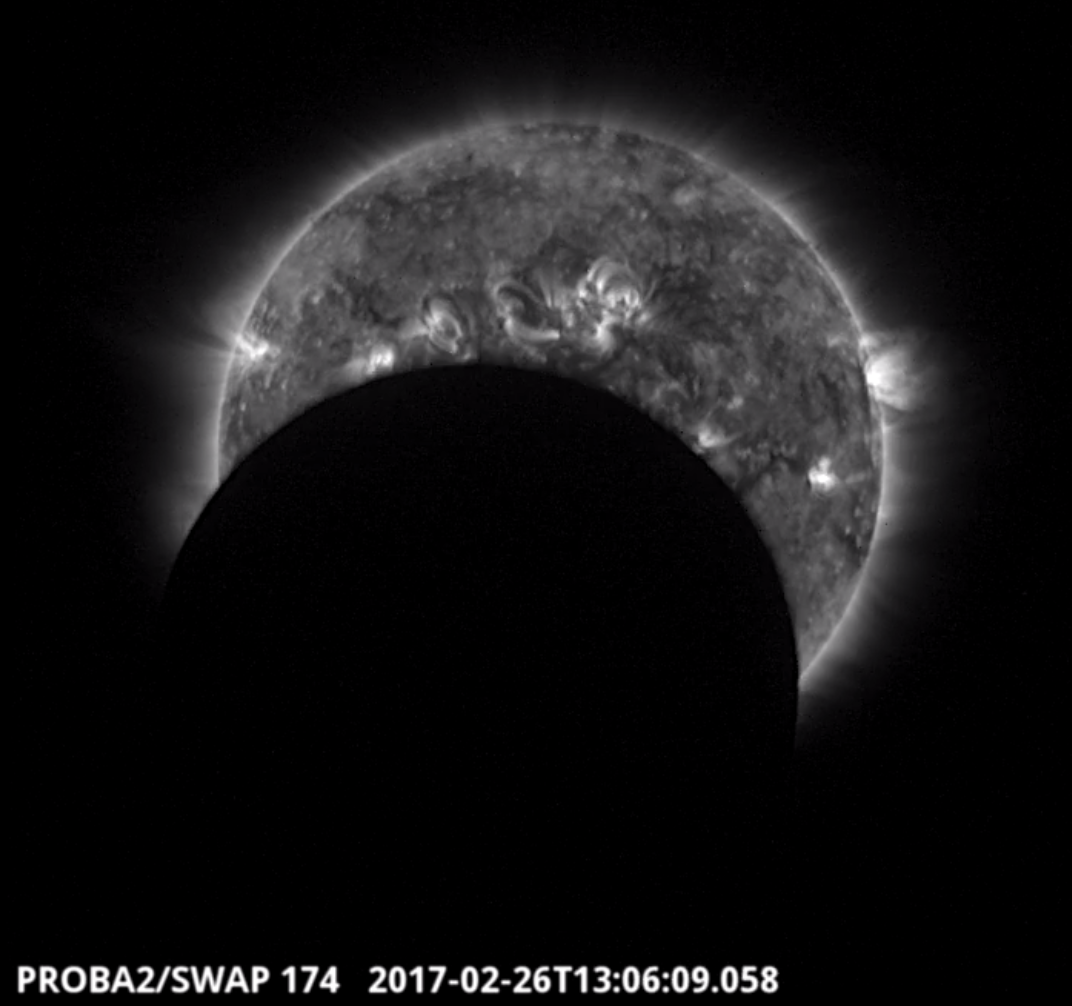
Eclipse Campaign in SWAP images on 2017-Feb-26.
Find a movie of the events here (SWAP movie):
http://proba2.oma.be/Events/2017-Feb-26_SolarEclipse/movies/swap_eclipse_2017_02_26_logos_lossless.mp4
The International Sunspot Number
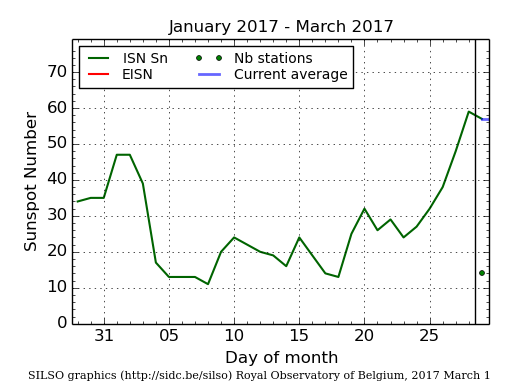
The daily Estimated International Sunspot Number (EISN, red curve with shaded error) derived by a simplified method from real-time data from the worldwide SILSO network. It extends the official Sunspot Number from the full processing of the preceding month (green line). The plot shows the last 30 days (about one solar rotation). The horizontal blue line shows the current monthly average, while the green dots give the number of stations included in the calculation of the EISN for each day.
Review of geomagnetic activity
Solar wind was determined by the influence of an elongated positive polarity coronal hole in the southern hemisphere. Its equatorial part transited the central meridian on February 20. Solar wind speed started increasing from around 400 km/s early February 23 to around 650 km/s on February 24 before gently declining back to 400 km/s by the end of the week (late February 26). Total magnetic field reached close to 13 nT in the compression region, dropping to a nominal 5nT in the high speed stream proper. The Bz was variable throughout the period, with peaks down to -11nT in the compression region.
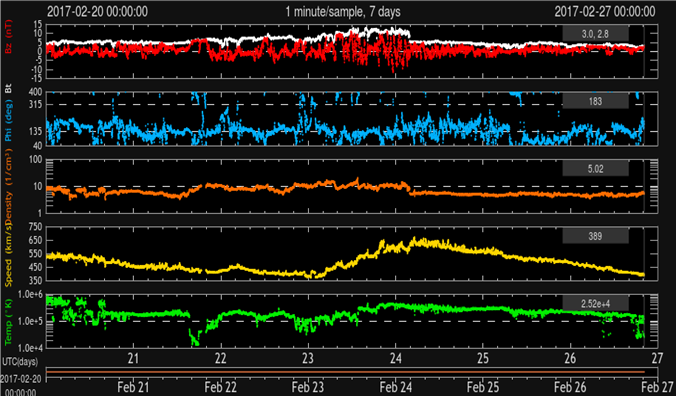
Associated to that, some periods of active geomagnetic conditions were recorded on February 23 and 24 (local K Dourbes), while NOAA Kp saw even one period of minor magnetic storming, but otherwise geomagnetic conditions were quiet to unsettled.
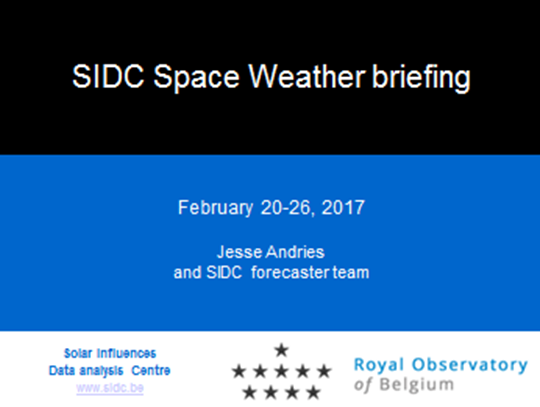
Download the running presentation of the Monday space weather briefing - http://www.stce.be/movies/SIDCbriefing-20170227.ppsm
Review of ionospheric activity (20 Feb 2017 - 26 Feb 2017)
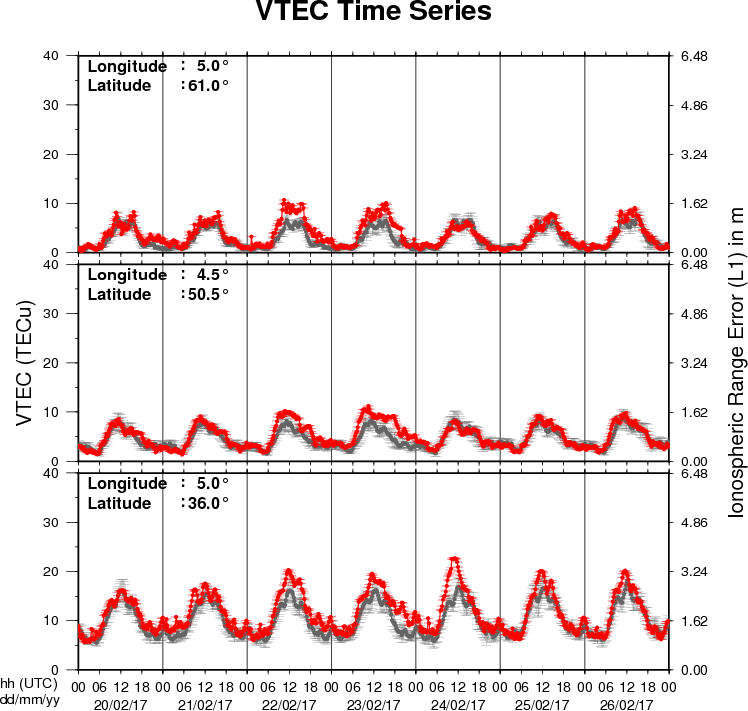
The figure shows the time evolution of the Vertical Total Electron Content (VTEC) (in red) during the last week at three locations:
a) in the northern part of Europe(N61°, 5°E)
b) above Brussels(N50.5°, 4.5°E)
c) in the southern part of Europe(N36°, 5°E)
This figure also shows (in grey) the normal ionospheric behaviour expected based on the median VTEC from the 15 previous days.
The VTEC is expressed in TECu (with TECu=10^16 electrons per square meter) and is directly related to the signal propagation delay due to the ionosphere (in figure: delay on GPS L1 frequency).
The Sun's radiation ionizes the Earth's upper atmosphere, the ionosphere, located from about 60km to 1000km above the Earth's surface.The ionization process in the ionosphere produces ions and free electrons. These electrons perturb the propagation of the GNSS (Global Navigation Satellite System) signals by inducing a so-called ionospheric delay.
See http://stce.be/newsletter/GNSS_final.pdf for some more explanations ; for detailed information, see http://gnss.be/ionosphere_tutorial.php
Future Events
For more details, see http://www.spaceweather.eu/en/event/future
International CCMC-LWS Workshop in Cape Canaveral, Florida (USA)
Start : 2017-04-03 - End : 2017-04-07
The goal of this working meeting is to address the need to
quantify and to track progress over time in the field of space
weather and to establish internationally recognized metrics that
are meaningful to end-users and developers. Defining a set of
appropriate metrics is important to track advancements in space
weather understanding and predictive capabilities.
This meeting is a part of the unfolding activities of the
International Forum for Space Weather Capabilities Assessment that
brings together space environment experts, model and application
developers, data providers, forecasters and end-users. The goals of
this community-wide forum include addressing challenges in
model-data comparisons and evaluating the current state of space
environment predictive capabilities. Workshop attendance is
encouraged but is not a requirement for joining forum teams.
Website:
http://ccmc.gsfc.nasa.gov/CCMC-LWS_Meeting/
Solar Orbiter Workshop 7: Exploring the solar environs in Granada, Spain
Start : 2017-04-03 - End : 2017-04-06
This event will be hosted by the Instituto de Astrofisica de
Andalucia - CSIC. Please mind that on April 7th the 20th SWT
meeting will take place at the same venue.
Website: Unkown
URSI General Assembly in Montreal, Canada
Start : 2017-08-19 - End : 2017-08-26
For the thirty-second time since the inception of URSI, Radio
Scientists from across the world will get together for the URSI
General Assembly and Scientific Symposium. This triennial gathering
will take place from 19th to 26th of August 2017, in Montreal,
Canada. This conference is a unique opportunity to learn about
recent advances in all fields of Radio Science, as covered by all
ten URSI Commissions.
Among the different sessions, please note:
* 'Radio Science for Space Weather'
Conveners: M. Messerotti, V. Pierrard
* 'Remote Sensing and Modeling of the Earth's Plasmasphere
and Plasmapause'
Conveners: A. M. Jorgensen, V. Pierrard, B. Heilig
The abstract deadline is 30 January 2017
Website: http://www.ursi2017.org
2017 Joint IAPSO-IAMAS-IAGA Assembly in Cape Town, South Africa
Start : 2017-08-27 - End : 2017-09-01
The Joint IAPSO-IAMAS-IAGA Assembly, endorsed by the University
of Cape Town and the South African Department of Science and
Technology, will take place from 27 August to 1 September 2017 at
the Cape Town International Convention Centre (CTICC). Several IAGA
and IAMAS sessions are of Space Weather interests as well as the
joint session 'Space Weather throughout the Solar System: Bringing
Data and Models together'.
Website:
http://iapso-iamas-iaga2017.com/index.php
Workshops on Radiation Monitoring for the International Space Station in Torino, Italy
Start : 2017-09-05 - End : 2017-09-07
The Workshop on Radiation Monitoring for the International Space
Station is an annual meeting to discuss the scientific definition
of an adequate radiation monitoring package and its use by the
scientific community on the ISS. Types of instruments and research
topics need to be defined in order to optimise the radiation safety
of the ISS crew.
Website: http://wrmiss.org/
European Space Weather Week 14
Start : 2017-11-27 - End : 2017-12-01
The ESWW is the main annual event in the European Space Weather
calendar. It is the European forum for Space Weather as proven by
the high attendance to the past editions. The agenda will be
composed of plenary/parallel sessions, working meetings and
dedicated events for service end-users. The ESWW will again adopt
the central aim of bringing together the diverse groups in Europe
working on different aspects of Space Weather.
Website:
http://www.stce.be/esww14/
